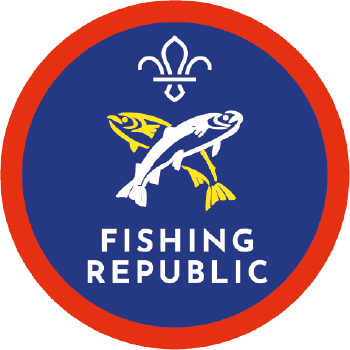
Gone fishin'
You’ll need
- String
- Sticky tape
- Poles or sticks
- A device to play music on
- A few songs on a playlist with a steady rhythm or beat
Before you begin
- Use the safety checklist to help you plan and risk assess your activity. Additional help to carry out your risk assessment, including examples can be found here. Don’t forget to make sure all young people and adults involved in the activity know how to take part safely.
- Make sure you’ll have enough adult helpers. You may need some parents and carers to help if you’re short on helpers.
Setting up the game
- Pick a large open space that lots of people can fit into.
- Create four fishing rods using the string and sticks. Make sure that the string is securely attached to the stick and won’t fall off when it’s pulled on. Depending on the general height of the young people playing the game, make sure the string is long enough to reach from their waist to the floor. A small weight, such as a 2p coin or a spoon, tied to the end may help, but it needs to be something that isn’t sharp or too heavy.
- Pick a song with a steady beat. Have a few songs standing by with different beats, so you can change it up between rounds. Some examples are Can’t Stop The Feeling by Justin Timberlake, Baby Shark, Roar by Katy Perry, The Bare Necessities from The Jungle Book or You’re Welcome from Moana, or Happy by Pharrell Williams.
- You may need to check the Music licence requirements for your meeting place or venue.
- Run through the safety rules for being around water. The players will need to be able to correctly identify these to score points.
- Check the weather forecast for changing conditions that affect the body of water you’re fishing.
- Always have someone else with you. You should never go alone.
- Have a throw line with you or be sure you know where one is and know how to use it.
- Pay attention to signage and warnings about the waterways you’re using.
- Be aware of the common features of your fishing environment.
- If on a boat, wear a life jacket or buoyancy aid, whichever’s applicable to your environment, and make sure it is fitted correctly.
- When freshwater fishing, set up on even ground.
- When you arrive at your fishing spot, check out the area around you and consider where you’d be able to get out of the water if you were to fall in.
- Know where you’re located and how to describe it in case you need to call the emergency services or report any hazards to a local authority.
- Only wade into the water where the current is weak.
- Keep clear from slippery banks or deep and fast flowing water.
- Beware of overhead cables. Poles and rods conduct electricity. They don't even have to be touching a cable for electricity to jump to them and cause a shock.
- Keep your space tidy. Don’t leave any trip hazards for passers-by.
- Be sure to look all around when using long poles and rods to be sure you don’t strike anyone or anything. You should look around for people, anything overhead (such as tree branches or cables) or steep slopes behind you.
- Be aware of how to safely assemble and take apart your tools. You should be particularly careful with sharp objects, such as your hooks.
- Don’t walk on ice covered water.
Start the game
- Gather everyone together in a tight circle and pick four players to be the anglers.
- Each angler needs to have a space aside to them to be their net, which is a space for all their captured fish to go and stand or sit in.
- The rest of the players are going to be the fishes in the game. You can rotate these roles between everyone as you go, so everyone has a chance to be a fish or an angler.
- The fish need to put their hands out in front of them, then open and close their hands to the beat of the music playing. An adult volunteer or young leader could do it too, as this may help everyone keep to the beat.
- You could do this activity without music and an adult volunteer or young leader could set a rhythm for people to open and close their hands to.
- The anglers need to get the string on their fishing rod safely into a fish’s hands.
- The anglers can get as close to the fish as safely possible and as close as the fish are comfortable with them getting.
- However, the anglers can’t touch or move the string with their hands or in any way other than through using or holding onto the fishing pole. Make sure everyone takes extreme care when using the fishing rods so the ends of the poles keep away from people’s faces.
- If an angler gets the string on their fishing rod safely into a fish’s hands, the angler must correctly name a water safety rule to capture that fish. If the angler names one correctly, they capture the fish.
- If it may be difficult for the volunteer running the activity to hear the water safety rules being shouted out, you could have a harbourmaster or harbourmaster’s table. Anglers need to take their fish to the harbourmaster, tell them their water safety rule and the harbourmaster can tell them if they’ve caught the fish or not, depending on whether their rule is correct. The harbourmaster could have a written or printed copy of the water safety rules, too.
- When an angler catches a fish, the fish needs to go to the angler’s base.
- The game could end when the song ends or when all the fish are caught. You can then play a game and swap out who the anglers are.
- The person with the most fish captured could be the winner.
- A volunteer needs to be near to the anglers to hear them say the water safety rule.
Reflection
This activity allows us to learn the safety rules of angling away from the water. Why are these safety rules important? What might happen if we do not follow them?
Safety
All activities must be safely managed. You must complete a thorough risk assessment and take appropriate steps to reduce risk. Use the safety checklist to help you plan and risk assess your activity. Always get approval for the activity, and have suitable supervision and an InTouch process.
- Active games
The game area should be free of hazards. Explain the rules of the game clearly and have a clear way to communicate that the game must stop when needed. Take a look at our guidance on running active games safely.
- Visits away from your meeting place
Complete a thorough risk assessment and include hazards, such as roads, woodland, plants, animals, and bodies of water (for example, rivers, ponds, lakes, and seas). You’ll probably need more adult helpers than usual. Your risk assessment should include how many adults you need. The young people to adult ratios are a minimum requirement. When you do your risk assessment, you might decide that you need more adults than the ratio specifies. Think about extra equipment that you may need to take with you, such as high visibility clothing, a first aid kit, water, and waterproofs. Throughout the activity, watch out for changes in the weather and do regular headcounts.
To make it harder, you could choose a song with a faster beat or one with a slower beat to make it easier.
You could assign colours to the player and the fish. There should be four colours in total, one for each angler. The anglers can now only catch fish in their assigned colours and can only win by catching all their fish.
If anyone may struggle to open and close their hands in this game, could they do a different task, such as being the harbourmaster or playing the music?
If anyone may struggle to remember the water safety rules, could they instead be read a rule with a missing word, and they must fill in a blank? Or could they have half the rule read to them and they must finish the sentence?
Anglers could work in pairs, too. This may help people who might struggle with hand-eye coordination or remembering the rules.
You could use a slower rhythm if anyone may struggle with hand-eye co-ordination or has dyspraxia.
All Scout activities should be inclusive and accessible.
